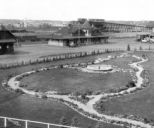|
The Calgary and Edmonton Railway
built 1890-91; leased (short
term) to Canadian Pacific Railway 1891;
leased (long term) by Canadian Pacific Railway as subsidiary 1904
(Red Deer & Leduc subdivisions 1908-present)
Revised April 2022
Photo descriptions
and credits at bottom of page.
When the transcontinental Canadian Pacific Railway arrived in Calgary in
1883, land quickly opened up along the line for development and for a
relatively economical way to move agricultural products. But there were
still vast areas for potential settlement beyond the 10-20 mile range
that the new railway served. There were also other communities in the
west that were not served by the railway, including Fort Edmonton. Branch
lines would be essential for the railway to prosper.

Meanwhile, the
Calgary and Edmonton Trail
quickly gained major significance as the north-south stagecoach route
between Calgary and Edmonton, carrying freight, passengers and mail.
It wasn't long before the value of a railway joining Alberta's two major
population centres became obvious.
In 1885, a charter was granted to the Alberta and Athabasca Railway
Company to run a rail line from Calgary to Edmonton and on to Athabasca
Landing. Construction was to start in the summer of 1887, run east from
Calgary to Drumheller (due to potential oil and coal fields) and north
along the west side of Buffalo Lake to Edmonton (later adopted by the
Grand Trunk Pacific Railway).
When the company had trouble financing the project and oil was not
found at Drumheller, a revised new charter was to take the railway near the proposed
Alberta Lumber Company facilities (built in 1887) near Innisfail, owned
by the same principals as the railway. Grading commenced in 1887 but
stopped after a month due to continued financial problems.
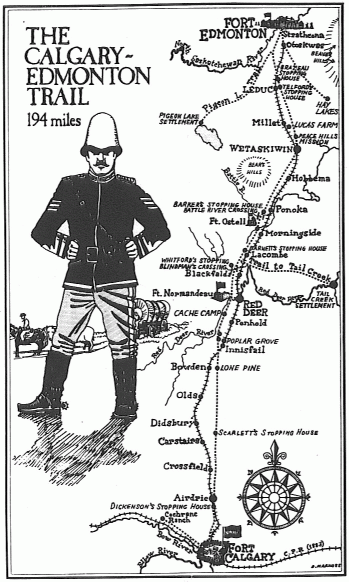
The charter was revised again with a new proposed route that would cross
the Red Deer River near the mouth of the Blindman River (a few miles
northeast of the current city of Red Deer). Again, financial problems caused the
charter to be extended with a new name, the Alberta and Great
Northwestern Railway. In early 1890, interests were sold to a new
venture, the Calgary
and Edmonton Railway Company.
The new company was incorporated by the federal government to build a
railway from Calgary north to a point at or near Edmonton (about 190 miles)
and from Calgary south to Fort McLeod and on to the international boundary. It
was also given the right to extend northward toward the Peace River
area. For each mile of railway constructed, the company would receive a
land grant of 2560 hectares (6400 acres). Selling and managing these
lands was the Calgary and Edmonton Land Co., incorporated in 1891.
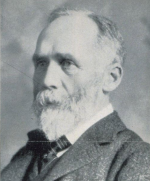 The
primary stockholders of the Calgary and Edmonton Railway Company
were James Ross, William Mackenzie, Donald Mann and Herbert Holt,
all very familiar with building railways. Mackenzie and Mann were
later to create and build the Canadian Northern Railway, a
subsidiary of which was the Canadian Northern Western Railway that
competed with the Alberta Central Railway. James Ross, the
supervising engineer for the Canadian Pacific Railway, who had
supervised several railway construction projects including the
transcontinental from Moose Jaw through the Rocky Mountains,
contracted his partners in the venture, William Mackenzie and Donald
Mann, to construct the C & E line. Holt became Superintendent of
Construction. The
primary stockholders of the Calgary and Edmonton Railway Company
were James Ross, William Mackenzie, Donald Mann and Herbert Holt,
all very familiar with building railways. Mackenzie and Mann were
later to create and build the Canadian Northern Railway, a
subsidiary of which was the Canadian Northern Western Railway that
competed with the Alberta Central Railway. James Ross, the
supervising engineer for the Canadian Pacific Railway, who had
supervised several railway construction projects including the
transcontinental from Moose Jaw through the Rocky Mountains,
contracted his partners in the venture, William Mackenzie and Donald
Mann, to construct the C & E line. Holt became Superintendent of
Construction.
The C & E Railway was an independent company but it never intended to
run trains. Its intention was to lease or sell the line to another
operator, specifically the Canadian Pacific Railway.
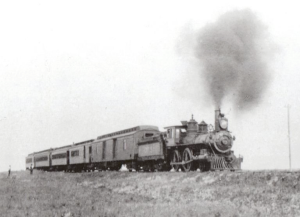
Much of the
line from Calgary toward Red Deer was surveyed in April and May
of 1890. The route more or less followed the Calgary-Edmonton Trail but
major adjustments needed to be made for reasonable grades and curves. In
addition, there was a significant challenge in crossing the valleys of
the Red Deer and Blindman Rivers, roughly half way between Calgary and
Edmonton. Three crossings of the Red Deer River had been surveyed -- one
near Innisfail, one at the Red Deer Crossing
settlement and another at the mouth
of the Blindman River which would enable the crossing of both rivers
simultaneously.
The official sod turning occurred in Calgary on July 21, 1890. During
that same month, Mr. Ross met with landowner Rev. Leonard Gaetz on his
land at the Red Deer River. The historic meeting resulted in the
abandonment of all three previously surveyed river crossings in favour
of a new one at the Gaetz homestead.
(The
C&E Railway at Red Deer)
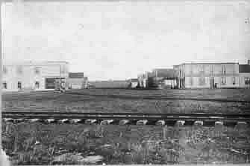 Rev.
Leonard Gaetz was one of the largest landowners near the river
downstream from the Crossing and was local agent for the Saskatchewan
Land and Homestead Company. He had
a great deal of political influence and was one of the principle
promoters of the region in his travels to Calgary and eastern Canada. When Rev. Gaetz
offered to Mr. Ross on behalf of the railway an undivided half interest
in his 1200-acre farm if the railway built the river crossing and new
townsite on his property, Mr. Ross gladly accepted. It also benefited
the financial position of Rev. Gaetz. Rev.
Leonard Gaetz was one of the largest landowners near the river
downstream from the Crossing and was local agent for the Saskatchewan
Land and Homestead Company. He had
a great deal of political influence and was one of the principle
promoters of the region in his travels to Calgary and eastern Canada. When Rev. Gaetz
offered to Mr. Ross on behalf of the railway an undivided half interest
in his 1200-acre farm if the railway built the river crossing and new
townsite on his property, Mr. Ross gladly accepted. It also benefited
the financial position of Rev. Gaetz.
Tracklaying reached the new Red Deer townsite in November
1890 -- a hundred miles in four months. That month,
the first passenger train ran from south of Red Deer (near present-day
Springbrook) to Calgary, as the four bridges needed to cross the
meandering Waskasoo Creek had yet to be constructed.
 During the winter of 1890-91, a wooden railway bridge was built crossing
the Red Deer River near the Gaetz homestead. Construction of the line
continued north toward Strathcona during 1891 with completion occurring
in July. Numbered sidings were established about every 9 miles. The line did not cross the North Saskatchewan River into
Edmonton until several years later due to the high cost of building a
bridge. During the winter of 1890-91, a wooden railway bridge was built crossing
the Red Deer River near the Gaetz homestead. Construction of the line
continued north toward Strathcona during 1891 with completion occurring
in July. Numbered sidings were established about every 9 miles. The line did not cross the North Saskatchewan River into
Edmonton until several years later due to the high cost of building a
bridge.
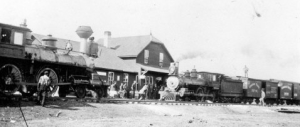 Once construction of the line was completed, the Canadian Pacific
Railway initially signed a
renewable 6-year lease and officially took over operations of the
railway in August 1891, named all the numbered stations along the route,
took an active role in the design of structures along the route, built a
telegraph line and started carrying the mail, taking it away from the
stage coaches along the C & E Trail. Regular scheduled passenger service
between the two major centres was in place by 1892,
reducing the travel time from 4 days by stagecoach to 12 hours by train.
This effectively put an end to the C & E Trail stagecoach service. Once construction of the line was completed, the Canadian Pacific
Railway initially signed a
renewable 6-year lease and officially took over operations of the
railway in August 1891, named all the numbered stations along the route,
took an active role in the design of structures along the route, built a
telegraph line and started carrying the mail, taking it away from the
stage coaches along the C & E Trail. Regular scheduled passenger service
between the two major centres was in place by 1892,
reducing the travel time from 4 days by stagecoach to 12 hours by train.
This effectively put an end to the C & E Trail stagecoach service.
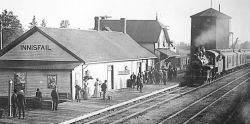 During 1891, virtually identical combination stations and freight house
were built in about three weeks at every even numbered siding. Any
settlers at intermediate sidings had to be satisfied with a temporary
station, usually a boxcar, for about 10-12 years. Larger communities
developed around the first stations built. During 1891, virtually identical combination stations and freight house
were built in about three weeks at every even numbered siding. Any
settlers at intermediate sidings had to be satisfied with a temporary
station, usually a boxcar, for about 10-12 years. Larger communities
developed around the first stations built.
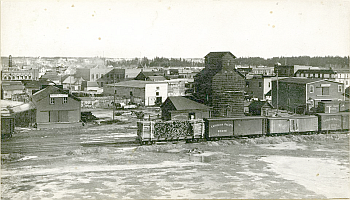 From
Calgary to Red Deer, communities with combination stations
included Airdrie (named after town in Scotland, Siding 2), Carstairs
(named after village in England, Siding 4), Olds (named after CPR
traffic manager, Siding 6), Innisfail (named after Celtic name for
Ireland, originally Poplar Grove, Siding 8) and Red Deer. From
Calgary to Red Deer, communities with combination stations
included Airdrie (named after town in Scotland, Siding 2), Carstairs
(named after village in England, Siding 4), Olds (named after CPR
traffic manager, Siding 6), Innisfail (named after Celtic name for
Ireland, originally Poplar Grove, Siding 8) and Red Deer.
Intermediate sidings with temporary stations included Beddington, Crossfield
(named after CPR engineer), Didsbury (named after village in England)
and Bowden (named after village in England). Additional passing sidings were at Burnson,
Balzac, Wessex, Rosebud, Neetook and Tuttle.
 From Red Deer to South Edmonton, communities with combination stations included Lacombe
(named after Father Albert Lacombe, Siding 12), Ponoka (Blackfoot word
for elk or wapiti, Siding 14), Wetaskiwin (Cree word for Peace Hills), Leduc
(named after Father Leduc, originally Telford)
and Strathcona (named after Lord Strathcona, Donald A. Smith, originally
South Edmonton and now part of Edmonton). From Red Deer to South Edmonton, communities with combination stations included Lacombe
(named after Father Albert Lacombe, Siding 12), Ponoka (Blackfoot word
for elk or wapiti, Siding 14), Wetaskiwin (Cree word for Peace Hills), Leduc
(named after Father Leduc, originally Telford)
and Strathcona (named after Lord Strathcona, Donald A. Smith, originally
South Edmonton and now part of Edmonton).
Intermediate sidings with temporary stations included Blackfalds (named
after area in Scotland, originally Waghorn, Siding 11), Hobbema (named
after Dutch painter, now called Maskwacis, Cree word for Bear Hills),
and Millet (named after canoeist for Father Lacombe). Passing sidings were at Labuma, Morningside,
Menaik, Navarre, Bigstone, Kavanaugh, Nisku and Ellerslie.
The Calgary to Fort Macleod leg was also surveyed in 1890 and
construction reached Mekastoe/Haneyville (three miles north of Fort
Macleod) in 1892. In 1898, a short link with the Crowsnest Pass line was
completed.
 South of Calgary, communities with combination stations included De
Winton, Okotoks, High River, Nanton and Claresholm. Intermediate sidings
with temporary stations included Midnapore, Aldersyde, Cayley, Stavely
and Granum. Additional passing sidings were at Turner, Academy,
Sandstone, Azure, Connemara, Durward, Pulteney, Woodhouse and Nolan. South of Calgary, communities with combination stations included De
Winton, Okotoks, High River, Nanton and Claresholm. Intermediate sidings
with temporary stations included Midnapore, Aldersyde, Cayley, Stavely
and Granum. Additional passing sidings were at Turner, Academy,
Sandstone, Azure, Connemara, Durward, Pulteney, Woodhouse and Nolan.
With almost 300 miles of construction complete, the C & E
Railway received a total land grant of 1.8 million acres.
By the turn of the century, Mackenzie and Mann were buying up small
railway companies and creating others with the intention of building a
new
transcontinental Canadian Northern Railway in direct competition with
Canadian Pacific. One of these small railway companies was the Edmonton Yukon and Pacific Railway
chartered in 1902 in part to link downtown Edmonton with the CPR in
Strathcona, creating a threat to the
Canadian Pacific's influence in the area.
Meanwhile, Mackenzie and Mann were also eyeing the Calgary and Edmonton
Railway, which they had built, for absorption into their Canadian Northern.
After the
original 6-year lease, Canadian Pacific had been renewing annually. As
CP had first option to lease or buy the Calgary & Edmonton Railway, CP signed a 999
year lease in 1904 to thwart any takeover move by the
Canadian Northern and within the next few years purchased all remaining stock to
make the C & E Railway a wholly-owned subsidiary of the CPR.
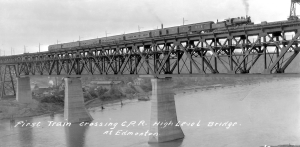
In June 1903 Canadian Pacific received authority to construct a high
level bridge across the North Saskatchewan River to link Strathcona with Edmonton as well as two branchlines
to extend 100 miles east of the C & E at Wetaskiwin and Lacombe.
The CPR also started constructing new stations at all the intermediate
sidings. Within a few more years, Canadian Pacific started plans to
replace some of the stations built in 1891 with larger ones at
significant junctions.

In 1905, the branch from Lacombe to Alix was opened and
extended to Stettler the following year. The line was further extended
to Castor in 1910, to Consort in 1912 and to Kerrobert in 1914. Meanwhile
the branch line
from Wetaskiwin east to Camrose also opened in 1905 and extended to
Hardisty the following year. The line was completed to Saskatoon by 1910
and became the main line between Winnipeg and Edmonton.
Residents of Strathcona became concerned that the future construction
of the High Level Bridge could diminish the town's importance. In
1906, Canadian Pacific made an agreement with the town that it would
remain the main divisional point for northern Alberta including the branchline
between Wetaskiwin and Winnipeg in return for a
land grant from the town and tax concessions. A new chateau-style
station was built at Strathcona in 1907.
 In
1908, Red Deer also became a divisional point and the wooden bridge
across the Red Deer River was replaced with steel. In 1910 a new
chateau-style station
was built at Red Deer similar to the one at Strathcona. New stations
were also built at Wetaskiwin in 1907, Lacombe in 1911 and Leduc in
1914, all of which replaced the original combination stations which were
relocated and converted to freight sheds. In
1908, Red Deer also became a divisional point and the wooden bridge
across the Red Deer River was replaced with steel. In 1910 a new
chateau-style station
was built at Red Deer similar to the one at Strathcona. New stations
were also built at Wetaskiwin in 1907, Lacombe in 1911 and Leduc in
1914, all of which replaced the original combination stations which were
relocated and converted to freight sheds.
Construction of the High Level Bridge commenced in 1910 and opened for
traffic in June 1913. The bridge was unusual in that it was used for
the railway and municipal streetcars on the top deck with vehicle traffic on the lower deck.
Most expansions effectively came to an end with the start of the First
World War and considerable focus was placed on moving military personnel
and supplies. After the war, the railway stayed fairly stable until the
early 1930s when the Great Depression and drought on the prairies
reduced the amount of traffic on most railways in the West. However,
Canadian Pacific used the time to prepare for increased business once
things turned back to normal.
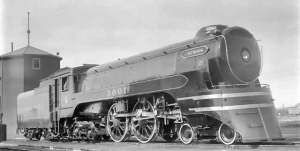
In 1936,
CPR introduced a fast passenger train on the C & E called 'The Chinook'.
It was headed by a specially-designed locomotive for fast inter-city service, the
4-4-4 Jubilee no. 3001. Only five of its class were ever built and none were
preserved. Except during the Second World War years, the 'Chinook'
5-hour service between Calgary and Edmonton ran in addition to the daily 'Eskimo/Stampeder' trains
and two other intercity trains until 1955.
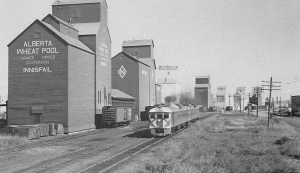 The first freight diesel ran on the line in 1949 and the 'The Chinook'
was
replaced by a 'Dayliner' Budd Rail Diesel Car in 1955, cutting the five-hour trip by
one and a half hours. Shortly afterwards, the other passenger trains
were also replaced by 'Dayliners'. The 3-per-day Dayliners reached their peak in 1969
with 80,000 passengers carried. Gradually, the number of Dayliner runs
dwindled to one per day. The first freight diesel ran on the line in 1949 and the 'The Chinook'
was
replaced by a 'Dayliner' Budd Rail Diesel Car in 1955, cutting the five-hour trip by
one and a half hours. Shortly afterwards, the other passenger trains
were also replaced by 'Dayliners'. The 3-per-day Dayliners reached their peak in 1969
with 80,000 passengers carried. Gradually, the number of Dayliner runs
dwindled to one per day.
Passenger
service ceased across the High Level Bridge in 1972 when Strathcona
again
became the northern terminus. In 1985, passenger service came to a
complete end with the 'Dayliner' making its final run on the C & E after 94 years
of continuous service. Proposals for new passenger service
surfaced that included new-generation LRC locomotives operated by VIA
Rail on CP or even a high-speed service, neither of which has so far
become a reality.
Remnants of the steam era no longer used by the railway include the High
Level Bridge in Edmonton still used for vehicle traffic and some tourist
streetcar excursions, the Red Deer
River bridge at Red Deer used as part of the Trans Canada Trail and
restored railway stations at Strathcona, Red Deer and Didsbury. The
Bowden station has been relocated to the Innisfail Historical Village. A
scaled-down replica of the Wetaskiwin station is located at the Alberta
Central Railway Museum 16 km southeast of Wetaskiwin. Other replications
of stations are at Penhold, Lacombe and Strathcona.
Photo descriptions and credits:
Header: Red Deer CPR 1910 station,
park and C&ER 1891 combination station as freight house 1911
(Red Deer Archives P3202);
Illustrative Map of Calgary Edmonton Trail and Calgary & Edmonton
Railway
(Historic Trails Alberta by Mark Anderako 1985,
Lone Pine Publishing Edmonton with permission);
Illustration of Calgary Edmonton Trail stagecoach
(The Little Village That Grew: A History of North
Red Deer by Red Deer & District Museum Society 1987);
James Ross photo (source unknown);
Early 1900s train on C&E near Red Deer (Red Deer Archives);
Early Red Deer c1891 (Red Deer Archives);
Red Deer C&ER timber bridge 1892 (Provincial Archives of Alberta
B2852);
CPR train meet Innisfail c1900 (Glenbow Archives NA-103-4);
Innisfail C & E Railway 1891
combination station 1890s (Glenbow
Archives NA-1709-71; Red Deer Archives);
Red Deer yard including Dominion elevator (Red Deer Archives P3550;
date unknown);
Lacombe C & E Railway 1891 combination station 1910 (Lacombe & District
Historical Society);
Okotoks C & E Railway 1892 combination station 1909 (Okotoks Museum
& Archives);
First train to cross the High Level Bridge Edmonton June 1913
(Provincial Archives of Alberta);
Lacombe replacement CPR woodframe station 1916 (Canadian Pacific
Archives);
Red Deer station and garden c1919 (Glenbow Archives na-3705-9;
Red Deer Archives);
CPR Jubilee 4-4-4 3001 in Calgary August 1938 (Otto Perry);
Dayliner at Innisfail late 1960s (Canadian Pacific Archives, via
Canadian Pacific in the Rockies Vol. 3 BRMNA)
Photos courtesy of Red Deer
Archives, Provincial Archives of Alberta, Canadian Pacific Archives,
Glenbow Archives,
Red Deer & District Museum Society, Lacombe & District
Historical Society, Mark Anderako and
Paul Pettypiece.
|
